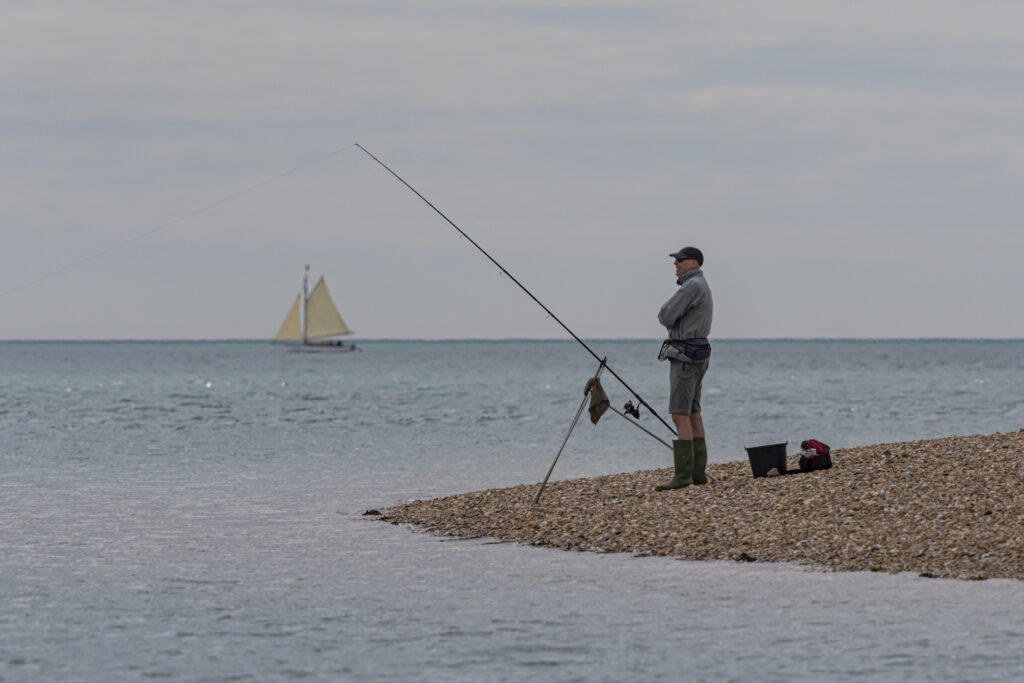With the twice daily transformation from acres of saltmarsh and mudflats to a watery mass lapping up to its banks and sea walls Chichester Harbour presents a considerable challenge to the sea angler. Although traditional shore and small boat angling remains popular those of a more adventurous nature have been developing fly fishing techniques in recent times with some success and the angling kayak is now seen in increasing numbers on harbour waters.
Angling from the Shore
The major difficulty for the conventional shore angler is that for many venues action is limited to an hour or two on either side of high water while there is a sufficient depth of water to hold the fish.
However, with its miles of coastline there are many opportunities for light tackle anglers to try their luck wherever there is access to the shore.
Look out for the slightly deeper channels where land drainage outfalls or small streams flow across the high tide line and try using a carp rod with suitably scaled down reel and terminal tackle rather than a full powered beach casting set up. Here again is an ideal situation for the fly fishermen to explore.

As the tide ebbs away shore angling becomes limited to where there is a relatively hard seabed. Remember the mudlands are very soft indeed and can easily catch out the unwary! Best opportunities for low water angling are either very early in the mornings or late evenings running into the darkness when there should be a lot less activity from other Harbour users. Places to try include New Cut on the northern Hayling Island shoreline, Langstone Wadeway, Emsworth foreshores, Cobnor point, Chidham directly opposite Bosham village, Dell Quay, Copperas Point, Itchenor foreshores and Mill Rythe.
Other possible low tide venues are on the Hayling side of the Harbour entrance with the deep water channel from Eastoke Point up to the Sailing Club being close inshore. This can be a challenging spot especially as the tidal slack is only of short duration. If there is a lot of weed in the water angling is only possibly for heavy tackle users and not even then on the biggest of spring tides. The shallow sandy flats on the Wittering side is ideal for the low water fly fisherman although care should be taken to avoid being cut off by the incoming tide advancing up any inshore channels.
Small Boat Anglers
Small boat anglers, if possible, should try to explore the Harbour at all stages of the tide. At low water look out for where the smaller rythes join the main channels as these will be the initial routes for fish to take as the flood tide builds and spreads out over the mudflats. Either anchor at these cross roads or try drifting up with the current. On the ebb try to reposition over a similar spot. The Harbour entrance can be productive but care should be taken when there is a wind-over-tide swell rolling. Again floating weed can be a problem especially on the ebb of big spring tides. Try anchoring just off the main boating channels on a gently rising bank. Just a little further are the Bracklesham and Medmerry marks giving good general angling.
Large Boat Fishing
For the larger trailed angling boats and marina based vessels Chichester Harbour is a gateway to the deeper waters of the Eastern Solent, the mixed grounds off Selsey Bill and further afield to the mid-Channel wrecks and reefs.
Weekends and Busy Times
Anglers should always be aware that at most weekends, especially during the summer, the Harbour is very popular with all sorts of boat users. It makes no sense for any angler to anchor up in the middle of a busy channel and expect everybody else to sail around. Similarly, avoid long-range shore casting – many competent anglers can easily reach out to 150 metres – into a crowded boating lane. Chichester Harbour is a renowed yachting venue with many of the local clubs hosting weekend racing events. The practicalities of yachting are very wind and tide dependant so a racing course cannot be set up until just before the start. Boat anglers should be aware that large yellow, mainly inflatable, markers are the rounding points for racing courses and plenty of room should be left for racing boats to turn.
Bait Digging
Digging for bait in the Harbour is controlled by a byelaw and restricts the areas that are available. Over-digging has depleted the colony of harbour ragworms so please – only take what you intend to use and fill in the holes you have dug.
Commercial Fishing
A small fleet of fishermen operates from the Harbour, often fishing in the wider Solent. Fishing activities are regulated by the Southern Inshore Fisheries and Conservation Authority (SIFCA).
The Harbour is a nursery for bass and the health of the juvenile fish is monitiored and recorded regularly by SIFCA. There is a small oyster fishery which is also monitored by the Chichester Harbour Oyster Partnership Initiative (CHOPI) – a partnership comprising the Conservancy, Sussex IFCA and Natural England.
Fisheries Regulations for Bass within Chichester Harbour
1. Bass Nursery Areas: Within any part of the harbour (definition of area below) (i) fishing for bass from any boat is prohibited between 30th April and 1st November and (ii) fishing for any type of fish using sand-eels for bait from any fishing boat is also prohibited during the same period.
Definition of Area: All tidal waters enclosed by a line drawn 192º true from Eastoke Point to Chichester Bar Beacon then 078º true to Cakeham Tower.
2. Minimum size: The Undersize Bass Order. The prescribed minimum size for bass is 42cm in length.
These regulations are subject to change. Please check www.sussex-ifca.gov.uk and www.southern-ifca.gov.uk for up to date information.